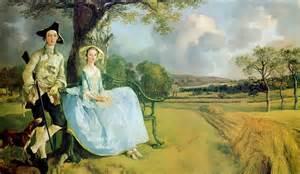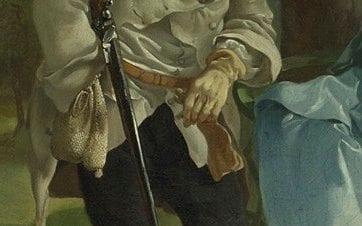https://www.telegraph.co.uk/news/2017/10/10/gainsborough-masterpiece-contains-phallic-symbols-work-secret/

According to the National Gallery, it is a Gainsborough masterpiece celebrating a marriage, starring a fashionable young couple and an unfinished spot on the bride’s lap for a future child to be painted in.
That description, according to an art historian, should be swiftly updated, to take in a new theory: the artist was sending up his subjects with a series of rude symbols while hell-bent on revenge.
James Hamilton, author of a new biography on Gainsborough, said he believed the painting of Mr and Mrs Andrews, owned by the National Gallery, should be immediately reappraised, admitting the true nature of the work was so scandalous they may need to be careful in their wording.
His new book details his reexamination of the famous painting, recasting it not as a celebration of the union of two landed families, but a bawdy mockery of the Mr and Mrs Andrews he had fallen out with.
“Certain signs point towards the painter’s revenge,” he said.
Among the hidden signs Hamilton claims to have identified are two donkeys trapped in a pen, added in the far background to the left of the painting, a “phallic” bag tied to Mr Andrews hip complete with “floppy leather glove” and a doodle of a penis in Mrs Andrews’ lap.
The painting, completed by Gainsborough in Suffolk in 1748, is known to star Robert Andrews and Frances Carter, subjects of a carefully-arranged marriage to unite two large estates in Sudbury.Both families were well known to Gainsborough, with a one-time friendship between the artist and Mr Andrews.
But far from being a treasured gift, Hamilton said, the painting in fact disappeared: never named, mentioned in biographies or exhibited until centuries later.
“Something went very wrong," said Hamilton, an author, curator and lecturer. "By now, Gainsborough had every reason to hate the Carters.
"Gainsborough’s father John, not a very canny businessman, overreached himself.
"It may be that they forced him towards bankruptcy, with the painting being a way to settle the debt.
"Gainsborough seems to have thought that he might have some sport with the Andrews."
The details of the painting, he said, include a phallic drawing which matches a doodle found in the margin of one of Gainsborough's letter.
"Gainsborough was a randy gentleman living in a randy age," he said. "Sexual innuendo and graffiti were not foreign to him.
"A painting with such a high finish and express detail as Mr and Mrs Andrews would not have been left in that state [partly unfinished] and delivered without a clear understanding, serious discussion or a fundamental falling out.
"The portrait such as this with a clear dynastic intent and clear social markers would have been completed unless death or another such disaster had intervened.

“If there had been serious discussion about its content, that discussion would have been resolved.
"The only reason left is a fundamental falling out. Given Gainsborough’s volatility, we have a final curt argument as the most likely reason for the lack of finish.
"It was never given a title, it was never engraved, and was put away out of the public gaze until the 20th century when all involved were long dead and whatever controversy there was forgotten."
The painting was eventually bought by the National Gallery in the 1960s. The gallery currently describes Mr and Mrs Andrews as "the masterpiece of Gainsborough's early years".
"The landscape evokes Robert Andrews's estate, to which his marriage added property," it states. "The painting of Mrs Andrews's lap is unfinished. The space may have been reserved for a child for Mrs Andrews to hold."
Asked if he believed the gallery should update the citation, Hamilton said: “Yes. Although how they would word it, I don’t know.”
